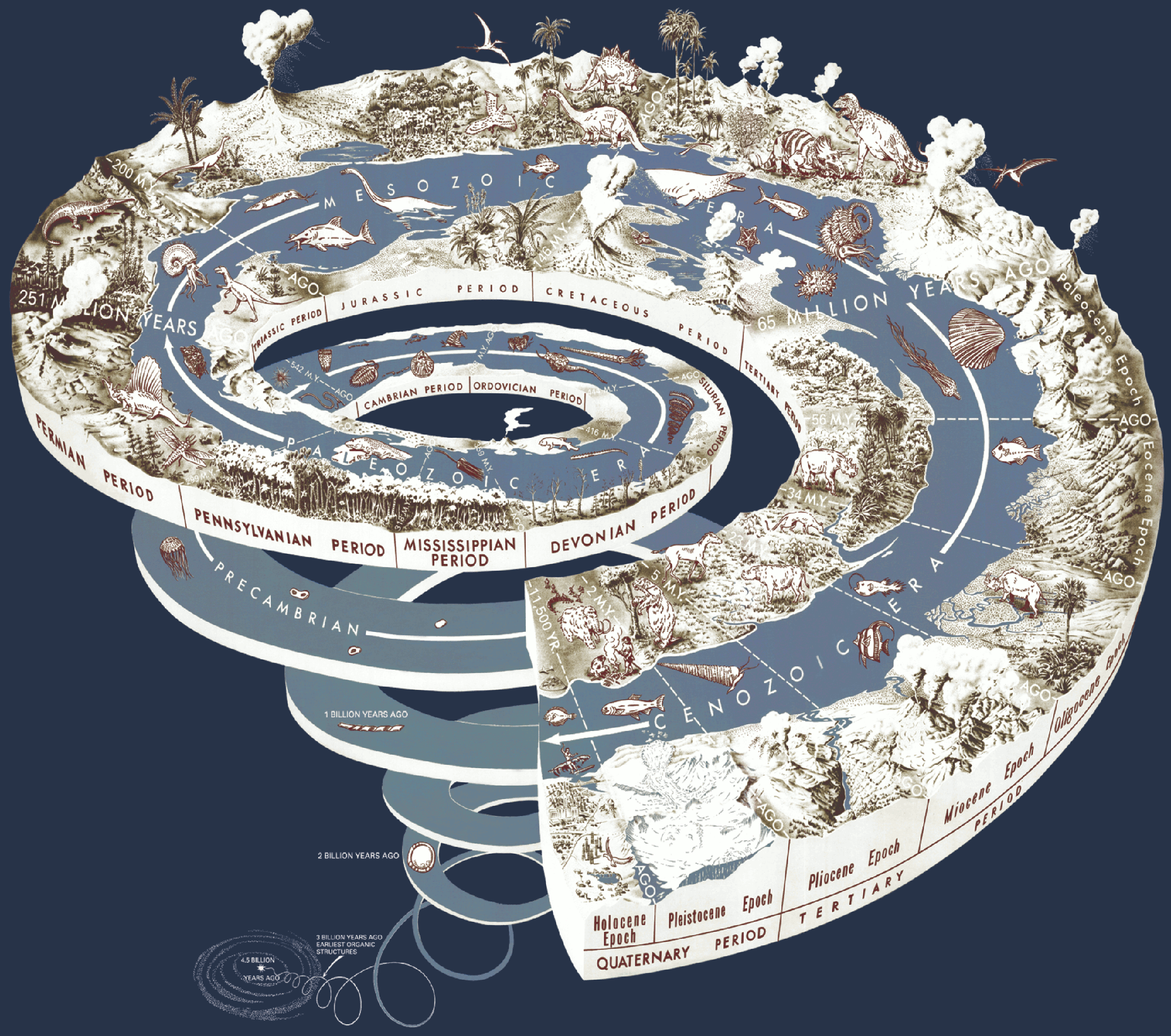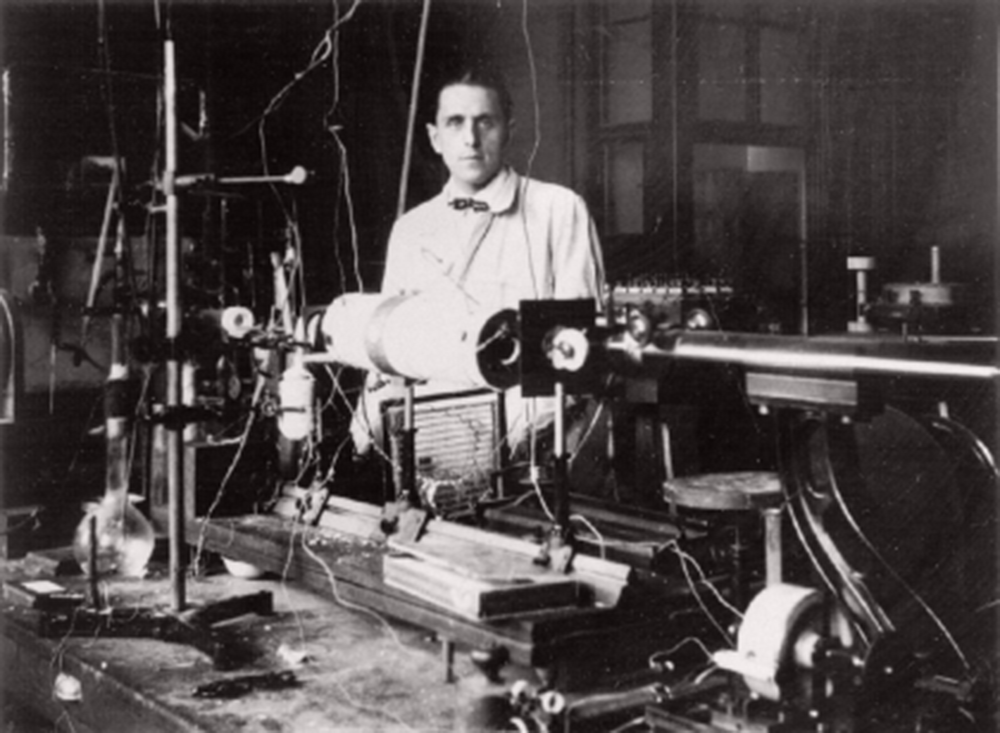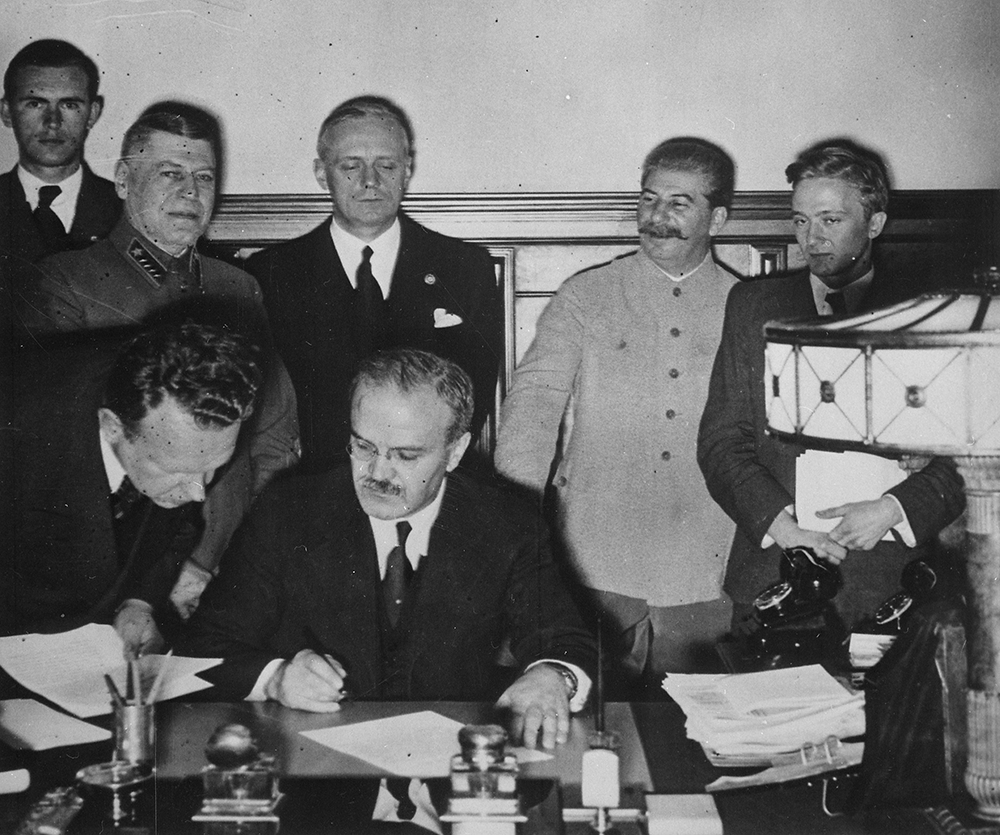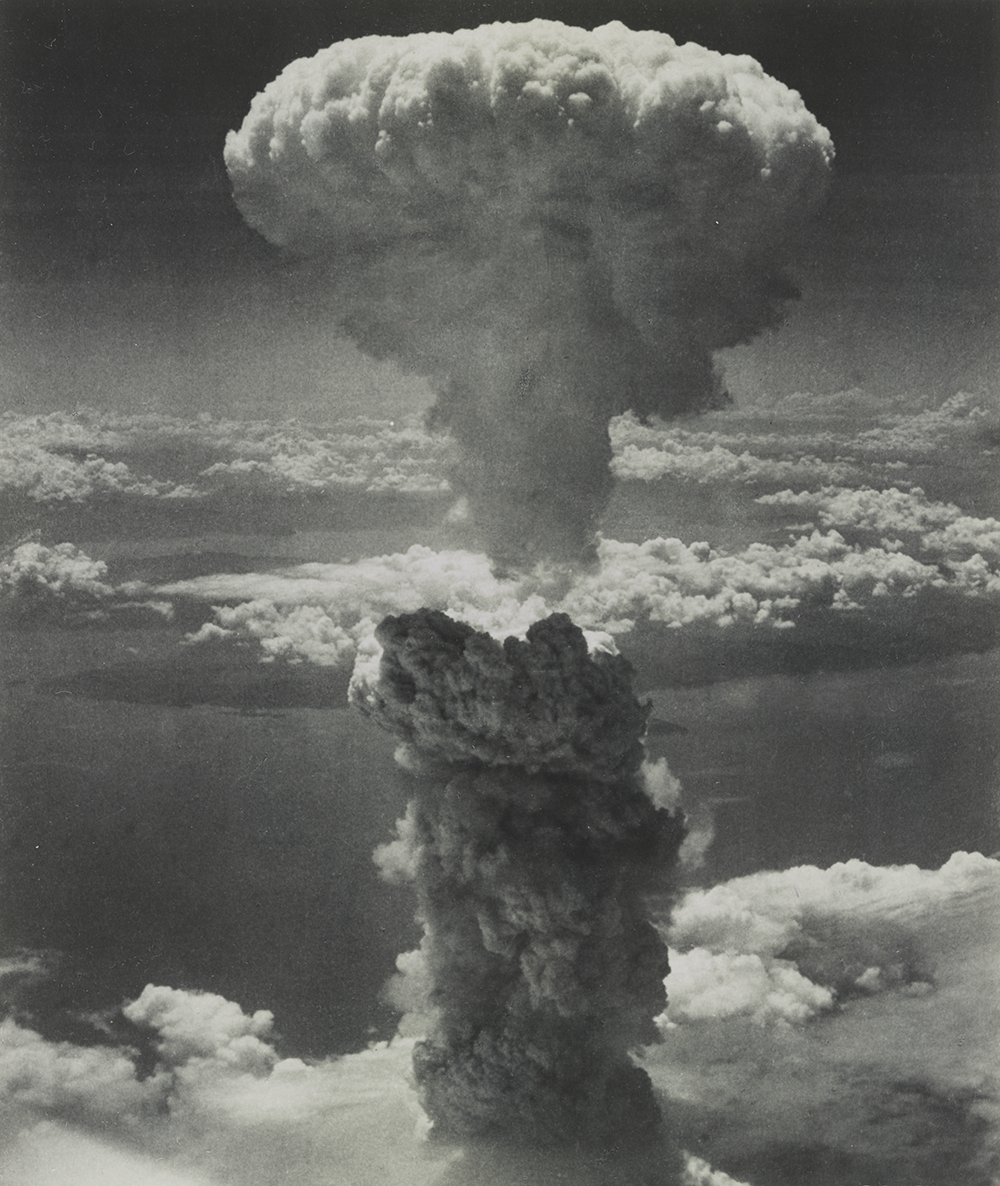
“The Geological Time Spiral—A Path to the Past,” designed by Joseph Graham, William Newman, and John Stacy, 2008. U.S. Geological Survey.
Eleven Days
The first full interrogation of German scientist Felix Houtermans by the NKVD took place in January 1938 in Kharkov, to which he had been transported after his arrest in Moscow a month before. It lasted eleven straight days, a procedure known to the secret police as a “Conveyor.” During those eleven days Houtermans was given only two breaks, of five hours on the first day and two hours on the second. The rest of the time he was kept awake. After the fourth day, he was also kept on his feet. By the end, he was falling into unconsciousness every twenty to thirty minutes, and his feet were so swollen that his shoes had to be cut off afterward. The interrogators told him they were going to arrest his wife, that his children were going to be sent to an orphanage under new names, so he would never see them again. As he would later tell his cellmate, this last threat is what finally broke him.
The interrogators only had two questions: “Who induced you to join the counterrevolutionary organization?” and “Whom did you induce yourself?” Fritz told them everything they wanted to hear about what he had been doing since arriving in the Soviet Union with his family three years before. He said that he was a spy and had been sent to the Soviet Union by the Gestapo. That he had designed a machine that could measure the speed of airplanes with lines of magnetic force. That the focus of his espionage was nuclear physics. That he knew how to bring about a chain reaction—even though this was 1938, when no such thing had been done before, and no one would actually accomplish it for another four years.
Sixty-Three Years
Born in Poland in 1903, raised in Vienna, and educated in Germany, Houtermans was deported from the Soviet Union as a German spy two years after his interrogation, in 1940. But once back in Germany, he was arrested again—this time as a Soviet spy. At the time of his death in 1966 he was living in neither country: he had left for Bern, Switzerland, where he ran a physics institute.
During his sixty-three years, Houtermans work had reconnoitered the extremes of time, examined the lifespan of the world. He had once helped to give the Earth its birth date. Had he acted differently at one crucial juncture, he might have helped destroy it.
Five-Year Plan
Joseph Stalin announced the first Five-Year Plan in 1928. The Soviet Union would build a new socialist state and a fully nationalized economy. The industrial progress that had taken the West a century to achieve the Soviet Union would accomplish in half a decade. Whole industries were going to be built from scratch, and the nation’s many peasants were going to be settled on efficient collective farms. The first plan was deemed such a success that Stalin announced that another one would begin in 1933. Only three years later, in 1936, he proclaimed that full socialism had been achieved. Class conflict and capitalist exploitation no longer existed in the Soviet Union. “Life is getting better, comrades,” Stalin told his country. “Life has become more cheerful.”
Fritz Houtermans arrived in the Ukrainian Socialist Republic with his wife and daughter in February 1935, during the abbreviated enactment of that second plan. His family’s emigration to the Soviet Union stemmed in part from equal parts necessity and conviction. Houtermans’ father was a Dutch businessman who had settled in what is now Poland, and his mother came from Vienna. She was an accomplished scientist, the first woman in that city’s history to receive a doctorate in biology; she was also half-Jewish, which made Fritz what the Nazis called a Mischling, or half-breed. From 1928 to 1933 Fritz Houtermans had worked in Berlin as an assistant to the renowned experimental physicist Gustav Hertz, but when Hitler came to power at the start of 1933, Houtermans’ wife Charlotte—who was also trained as a physicist and had witnessed the early years of the Nazis’ rise to power—insisted that they should leave Germany. Houtermans was also a committed Communist—an identification that, following the Nazi-dominated elections of 1933, carried considerable risks of its own. So in the early summer of 1933 the Houtermans family left Germany and moved to London, where Fritz worked for the fledgling company EMI, before it became the famed recording giant. But the family hated the food in England, and Houtermans hated the science, so they decided to move again, this time to Kharkov (now Kharkiv), where he accepted a position at the Kharkov Physico-Technical Institute.

Their timing could hardly have been worse. The Houtermans arrived in a country gripped by mounting paranoia and fear. In December 1934, Sergei Kirov, the Communist Party boss of Leningrad, was assassinated by a disgruntled former cadre, setting off a wave of arrests and inquisitions. Meanwhile, the second Five-Year Plan wasn’t going well. There was famine in the countryside (some of it deliberate) and economic malfunction everywhere. Someone had to be at fault. Blame settled on foreign agents and saboteurs.
By 1937 the Great Terror was in full swing. Anyone with connections to the world outside the Soviet Union was a suspect. The atmosphere at the Physico-Technical Institute became unbearably tense. One after another, Fritz’s friends and colleagues were being arrested. Unable to withstand the pressure any longer, one of his scientific collaborators drank acid and threw himself from the institute’s windows. He survived just long enough to be arrested.
Charlotte and Fritz knew their turn was coming and decided to travel to Moscow, where they could apply for exit visas. On their way they saw peasants bound together with rope like cattle, herded onto trains for deportation to Siberia. Once in Moscow, they were surprised to receive their visas almost at once, but then Fritz made a grave mistake: he notified the police about the family’s planned departure, as he was required to do by regulations. The next day he was arrested. Charlotte took the children and fled for Latvia, from which she was able to escape to Denmark through the intervention of the physicist Niels Bohr, a family friend.
Two Years, Five Months, One Day
All told, Houtermans spent less than three years in Soviet captivity: first in Moscow; followed by Kharkov, at a prison called Kholodnaya Gora, or “Cold Mountain”; and then finally in Kiev. The cells in Kiev were underground and had no daylight. To pass the time, Houtermans tried to work out some problems in number theory, but prisoners were forbidden from having paper or books, so he used matches to write out his calculations on pieces of soap or in hidden places on the walls; he had to erase all his markings every time he left his cell for the toilet. Even with these difficulties, he managed to do some work. After thinking about one problem for a year, he arrived at a solution for a limited version of Fermat’s last theorem for n=3. He had no way of knowing that Leonhard Euler had proved the same thing 170 years before. Excited, he applied to the People’s Commissar of the Ukraine for some paper. When his request was denied, he went on a hunger strike.
Around this time Houtermans’ cell received another inmate, a historian named Konstantin Shteppa, who had taught medieval history at Kiev University. He was arrested for committing a series of political errors in his lectures, the worst of which was claiming that Joan of Arc had been “high-strung.” Later, this charge was expanded to claim that he had shared intelligence with the Japanese. When Shteppa arrived in his cell, he thought the NKVD was mocking him by making him room with a dead man—Houtermans had lost so much weight due to his hunger strikes and his tendency to trade what little food he had for cigarettes that he no longer appeared to be alive. His face was gray and his skin was so thin that Shteppa could see every bone. He was thus understandably relieved when the corpse introduced itself: “My name is Fritz Houtermans, a German…a physicist…a former member of the Communist Party…former emigrant from Nazi Germany…former professor at the Institute of Physics in Kharkov…former human being. And who are you?”
Later, in the cell they shared, Houtermans would wonder aloud what had become of his family. Shteppa in turn told him about his life in the Soviet Union and his work as a historian. At Kiev he had mostly taught the history of Byzantium, but his dissertation had been on demonology, with a special focus on the European tradition of witch trials. Over the months, they became close friends. In a memoir, Shteppa’s daughter later related how the two men came to share “one soul.” They would tell “one another everything about themselves, about their families, their experiences, their knowledge…They had the same fears, the same agonies, the same despair and hopelessness. They both were at the mercy of the NKVD. Each of them was completely sure that the other one would never come out alive.”
But somehow both men did manage to survive and, during the first days of the American occupation in 1945, they ran into each other on the street in Göttingen. It was as if fate had brought them together. They decided to write a book about their experiences in prison. It was published pseudonymously in 1951 as Russian Purge and the Extraction of Confession, by the invented authors Beck and Godin. Houtermans and Shteppa approached their task like scientists. They devised a scheme for classifying prisoners, charges, and styles of interrogation. Throughout, they tried to answer the same question Arthur Koestler had posed in Darkness at Noon: Why would innocent men confess to charges that weren’t true—charges that were not just false but, as with Houtermans’ and Shteppa’s supposed espionage, obviously absurd?
Shteppa and Houtermans tried to make their study as objective as possible and referred to themselves only in passing. But occasionally, they couldn’t help letting some of their experience slip through, as when they wrote about what went through prisoners’ minds after interrogation:
There was no question that excited the prisoners so much as...“Why? What for?” The question was endlessly argued in the wooden waiting cells, the “dog kennels” in which prisoners were put before and after interrogation. The words Why? What for? were to be found scratched with smuggled bits of broken glass on the inside walls of the prison van, “the black raven,” and the coaches of the prison trains. “Why? What for?”
Shteppa and Houtermans chose two epigraphs for their book. The first was their rendering of Stalin’s proclamation: “Life is getting better, happier!” The second read simply, “By this time the system had reduced itself to absurdity.”
Thousand-Year Reich
When Hitler came to power in 1933, he promised an empire that would last a thousand years. To do that, an empire needed weapons—and for that, it needed to make compromises. On August 23, 1939, Nazi Germany signed a Nonaggression Pact with the Soviet Union, which until then had featured in official rhetoric as Germany’s most despised enemy. In the months that followed, the two nations began negotiations over the return and exchange of “undesirable foreigners.”

The Soviet Union asked for its spies. Germany countered by asking for some of the many German citizens in Soviet jails. Houtermans was on one of these lists. On May 2, 1940, he was handed over to the Gestapo at the Soviet-German frontier, the so-called Peace Bridge over the River Bug. For Fritz, the repatriation did not grant him much in the way of freedom, as he was at first held in a Gestapo prison in Lublin. Then he was transferred to the central jail in Berlin. While there, he got word out to a friend of his from his Berlin days, the physicist Max von Laue. Despite being vehemently anti-Nazi, Laue had sway in German scientific circles; he had won the Nobel Prize in 1912 for discovering the diffraction of X-rays on crystals.
In a matter of weeks, Laue was able to get Houtermans out of jail. He even found him a job, at a private laboratory run by the prolific inventor Manfred von Ardenne. Ardenne’s lab enjoyed the patronage of the head of the Reich Postal Ministry, a man who dreamed of delivering a superweapon to the führer.
Hiring Houtermans made that dream a possibility. His training was in atomic and nuclear physics, and back in the 1920s he had done pioneering work on quantum tunneling with George Gamow and on nuclear fusion in stars with Robert Atkinson. Even in physics-mad Germany, Houtermans knew more than most about the behavior of atomic nuclei under duress and their potential to be weaponized. In 1932, before leaving Germany, he had conceived of the possibility of a nuclear chain reaction in his first lecture at the Technische Hochschule in Berlin. Now, back home and working in the postmaster’s private laboratory, he foresaw something no one else in Germany had thought of: the existence of an element heavier than uranium—element 94—that was likely to be highly fissionable and easier to separate than uranium-235. Houtermans wrote up his predictions in a 1941 report that stressed both the advantages of plutonium (then still totally unknown in Germany, though it had already been discovered in the United States) and the need for breeder reactors to synthesize it.
Had his advice been followed, it is possible that Germany could have built a bomb before the end of the war. Afterward, Houtermans tried to conceal his results as best he could. But he knew enough to be alarmed. Early in 1942 he realized that Werner Heisenberg, who had a leadership role in the German nuclear weapons program, had also ascertained the potential of the plutonium method. This prompted Houtermans to take a very risky step. Through an intermediary in Switzerland and despite being under Gestapo surveillance, he managed to send a telegram to physicists in America who he knew were working on nuclear fission as well. It read simply, “Hurry up. We are on the track.”
24,100 Years
The half-life of plutonium-239 is 24,100 years—slow in human terms, but quick enough to make it one of the most lethally radioactive isotopes on the periodic table.
The German belief in the country’s superiority played a decisive role in the failure of the country’s nuclear program. After the fall of Berlin in May 1945, a number of the leading scientists working in the program were detained by the Allies and taken to a country house in England called Farm Hall. There the scientists spent their days playing chess, organizing lectures, and discussing their failures. All their conversations were meticulously recorded by bugs laid throughout the house.

August 6, 1945, was an interesting day at Farm Hall, for it was then that the detained German physicists learned about the new weapon that had been dropped over Hiroshima. They did not believe that it could be nuclear. A few days later, they learned that another device, the comparably more sophisticated and destructive Fat Man, had been dropped over Nagasaki. There could be no question that this bomb had been atomic, but the Germans couldn’t figure out a way to make the numbers work: the mass of the bomb seemed much too small. It never occurred to them that it could have been made of plutonium, an element they didn’t believe could be synthesized in the necessary amounts. It couldn’t occur to them—to admit it also would mean admitting that all the work they had done had proved insignificant in the end. That in turn would mean admitting that someone out there was smarter than they were. And that was unthinkable.
4.5 Billion Years
The discovery of deep time is one of the signal achievements in the history of science. So much else depends on it: without it, evolution could not be thought; paleontology becomes nonsense, cosmology no more than theology. The discovery of the true age of the Earth has been justifiably likened to the Copernican Revolution. One took the Earth out of the center of the universe. The other moved humans from the prologue of creation to the index.
In 1582, when the great French humanist Jean Bodin began educating his three- and four-year-old sons, he started by teaching them to talk, in Latin, about angels, darkness, light, and the age of the world, which he knew to be precisely 5,534 years. For centuries, most Christians enjoyed a similar degree of certainty about the time that had passed since creation—not that there wasn’t room for controversy around the margins. Throughout the Enlightenment, the history of the Earth was still in essence a family affair, a matter of climbing down the chain of ancestry until one arrived at the Adam and Eve, the ancestors of us all.
Not everyone agreed with this short version of universal chronology. That the Earth might be a good deal older than the origin of mankind seemed a possibility even in antiquity. By the fourth century bc, Aristotle, noting the action of the Nile in building up its delta, reasoned that it now flowed over what once must have been dry land. From this he concluded that “time is infinite and the universe eternal.” Centuries later, other scientists tried to do Aristotle one better by using the fixity of natural processes not just to argue for the antiquity of Earth but also to establish its precise age. Edmund Halley hypothesized that a date could be fixed by calculating the influx of salt into the oceans but couldn’t quite figure out how. Benoit de Maillet tried to do it by tracking the decline in the level of the Mediterranean since his father’s time. Kepler tried by tracking the movement of the solar apogee. The great French naturalist Buffon reasoned that since there are great stores of heat in hot springs and underground mines, the whole Earth must once have been ragingly hot. So he tried to establish a date experimentally, by heating small iron spheres and observing the rate at which they cooled. His guess of 75,000 years wasn’t remotely right, but at least it broke with the four-digit timescale of his biblically minded predecessors. Reasoning along the same lines but armed with much better mathematics, Lord Kelvin announced in 1862 that the true figure was 98 million years, though he hedged by saying that it could be as few as 20 million and as many as 400 million years old. Sadly, Kelvin’s reasoning was faulty, and his estimate would go down as one of the great scientific blunders of his time. The true age of the Earth would have to wait.

The solution, ultimately, proved to be a matter of isotopes and stardust. While working at the University of Bern in Switzerland in the early 1950s, Houtermans was among those who realized that the radioactivity present at the beginning of the solar system could be used to date it. The dust clouds that eventually turned into the sun and the Earth contained a certain amount of naturally occurring uranium, in both the 235 and 238 varieties. Over the course of the Earth’s existence, much of these decayed into different isotopes of lead. If you know the half-lives of the uranium isotopes (700 million and 4.5 billion years, respectively) and the proportions of lead isotopes in naturally occurring minerals, you can determine the age of planet. For the technique to work, you also need minerals from somewhere else, though—ancient ones, dating back to the very birth of the planets. Houtermans and his collaborators found them in the sky. By using meteorites to calibrate their results, they were able to estimate the age of the Earth as 4.53 billion years.
Later, Houtermans helped develop a number of other dating techniques using radioactive decay series. Thanks to these new dating systems, the timeline of the Earth’s history moved from the relative time of Hutton to the absolute time of Einstein. The vistas this opened up are staggering. The 4.5-billion-year history of the Earth we now take almost for granted is a million times bigger (larger, not longer) than the one envisioned by Bodin. It is an ocean next to a drop.
What does one life mean next to that abyss?
Sixty-Five Years
Though the implications of his work were almost inconceivably large, Houtermans wasn’t a particularly self-reflective man (Russian Purge isn’t especially informative about his inner life). He was more of a wit, as well as an inveterate chain smoker. He liked to tell jokes. Sometimes those interests combined. When he was still working inside the Ardenne lab, he ordered a bag of premium Macedonian tobacco, claiming he needed it to produce deuterium for their nuclear reactor. The War Ministry sent Houtermans his tobacco. He smoked it, and then wrote to ask for another pound, at which point the Gestapo stepped in. Houtermans was lucky they didn’t take his life.
Two decades later, the cigarettes did the trick. When Houtermans died of lung cancer in 1966, he remained unaware of a major piece of information that recast the course of his life: his fellow prisoner, coauthor, and soulmate Shteppa had been an NKVD informant who had denounced dozens of his fellow faculty at Kiev University. After the Germans occupied Ukraine, he became a turncoat, serving in the division of pro-Nazi Russian defectors known as the Vlasov Army. When the army was defeated, it came time to switch sides yet again. Shteppa’s true identity as a stool pigeon didn’t come to light until the partial opening of the Ukrainian secret police archives in 2003, sixty-five years after he first met Houtermans in their Kharkov cell. This is one thing Houtermans never got a chance to measure: the lifespan of a secret—so much shorter than a planet, so much longer than a life.